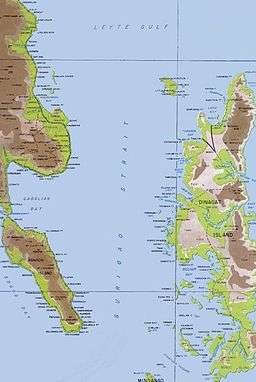Surigao Strait
| Surigao Strait | |
_is_underway_as_part_of_Carrier_Strike_Group_(CSG).jpg) The US Navy guided-missile destroyer USS Gridley in the Surigao Strait | |
| Country | Philippines |
|---|---|
| Region | Eastern Visayas, Caraga |
| Coordinates | PH 10°10′N 125°23′E / 10.167°N 125.383°ECoordinates: PH 10°10′N 125°23′E / 10.167°N 125.383°E |
| Length | 75 km (47 mi), N-S |
| Width | 25 km (16 mi), E-W |
 | |
Surigao Strait (Filipino: Kipot ng Surigaw) is a strait in the southern Philippines, between the Bohol Sea and the Leyte Gulf of the Philippine Sea.
Geography
It is located between the regions of Visayas and Mindanao. It lies between northern Mindanao Island and Panaon Island, and between the Dinagat Islands and Leyte island.
The strait is deep but has a strong current, up to 8 knots (15 km/h; 9.2 mph). The northern entrance of the Surigao Strait is marked by a navigation light on Suluan Island.[1]
Transport
It is regularly crossed by numerous ferries that transport goods and people between Visayas and Mindanao. The ferries stop at Liloan, Southern Leyte and Surigao City in Surigao del Norte.[2]
Etymology
According to legend, the strait was named after Solibao, a Negrito chieftain, who lived at the outlet of the Surigao River. Migrating Visayan fishermen gradually formed a settlement there, and when Spanish explorers visited the place, they probably misheard the name as Surigao instead of Solibao.[3] A different theory explains that Surigao may be derived from the Spanish word surgir, meaning "swift water" or "current".[4]
History
In March 1521 during the first circumnavigation of the Earth, Ferdinand Magellan and his crew were the first Europeans to sail through the strait.
The Battle of Surigao Strait took place here on October 25, 1944, when the "cross the T" incident took place as American battleships fired their guns over Vice Admiral Shoji Nishimura's Southern Force; nearly all of which, including the battleships Yamashiro and Fusō and others were sunk. Admiral Nishimura was killed in action when his flagship Yamashiro sank following actions against Jesse B. Oldendorf's battleships, all but one of which had been at Pearl Harbor.[5]
References
- ↑ "INBOUND THROUGH THE SURIGAO STRAIT" (PDF). Puerto Galera Yacht Club, Inc. Retrieved 22 July 2013.
- ↑ "About Surigao del Norte". Philippine Provincial Road Management Facility. Retrieved 22 July 2013.
- ↑ "Legend of Surigao City". www.surigao.net. Retrieved 22 July 2013.
- ↑ "Surigao Travel Information". Free N Easy Travel. Retrieved 22 July 2013.
- ↑ Zapotoczny, Walter S. (2008). "The Battle of Surigao Strait: The Last Crossing of the T". MilitaryHistoryOnline.com. Retrieved 22 July 2013.
External links
-
 Media related to Surigao Strait at Wikimedia Commons
Media related to Surigao Strait at Wikimedia Commons
